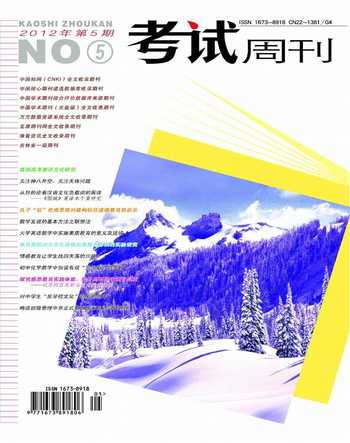浅议中考情态动词的复习策略
戢平
情态动词是一种本身有一定的词义,表示说话人的情绪、态度或语气的动词,但不能单独作谓语,只能和其他动词原形构成谓语。中考对该知识点的考查重点为:(1)情态动词在一般疑问句中的问与答;(2)情态动词表示猜测的用法;(3)need的用法。具体来说情态动词有四类:①只做情态动词:must,can(could),may(might)……②可作情态动词又可作实义动词:need;③具有情态动词特征:have(had,has)to,used to;④情态动词表猜测:一肯一否三不定(must一肯;must not一否;can,could,would三不定)。在复习时必须熟练掌握,具体复习策略如下。
一、掌握情态动词的语法特征
(1)不能表示正在发生或已经发生的事情,只表示期待或估计某事的发生。
(2)除have外,后面只能接不带to的不定式。
(3)没有人称、数的变化。
(4)没有非谓语形式,即没有不定式、分词等形式。
二、掌握比较各类的不同点
1.比较can和be able to。
(1)can could表示能力;可能(过去时用could),只用于现在式和过去式(could)。be able to可以用于各种时态。例如:
He will be able to tell you the news soon.他很快就能告诉你消息。
(2)could不表示时态。
①提出委婉的请求,(注意在回答中不可用could)。例如:
——Could I have the television on?我可以把电视开着吗?
——Yes,you can./No,you cant.是,你可以。/不行,你不能。
②在否定,疑问句中表示推测或怀疑。例如:
He couldnt be a bad man.他不大可能是坏人。
2.比较may和might。
(1)表示允许或请求;表示没有把握的推测;may放在句首,表示祝愿。例如:
May God bless you!愿上帝保佑你!
He might be at home.他可能在家。
注意:might表示推测时,不表示时态。只是可能性比may小。例如:
Peter ?摇?摇?摇come with us tonight,but he isnt very sure yet.
A.must?摇?摇B.may?摇?摇C.can?摇?摇D.will
答案B,表可能性只能用may.此句意可从后半句推出。
3.比较have to和must。
(1)两词都是“必须”的意思,have to表示客观的需要,must表示说话人主观上的看法,即主观上的必要。例如:
My brother was very ill,so I had to call the doctor at once.我弟弟病得很厉害,我只得立刻把医生请来。(客观上需要做这件事)
He said that they must work hard.他说他们必须努力工作。(主观上要做这件事)
(2)have to有人称、数、时态的变化,而must只有一种形式。但must可用于间接引语中表示过去的必要或义务。例如:
He had to look after his sister yesterday.他昨天必须照顾他妹妹。
(3)在否定结构中:dont have to表示“不必”,mustnt表示“禁止”,例如:
You dont have to tell him about it.你不一定要把此事告诉他。
You mustnt tell him about it.你一定不要把这件事告诉他。
(4)must表示推测。
①must用在肯定句中表示较有把握的推测,意为“一定”。
②must表对现在的状态或现在正发生的事情的推测时,must后面通常接系动词be的原形或行为动词的进行式。例如:
You have worked hard all day.You must be tired.你辛苦干一整天,一定累了。(对现在情况的推测判断)
He must be working in his office.他一定在办公室工作呢。
③否定推测用cant。例如:
If Tom didnt leave here until five oclock,he cant be home yet.如果汤姆五点才离开这儿,他此时一定还未到家。
4.表示要求,命令时,语气由should(应该)、had better最好)、must(必须)渐强。
(1)had better表示“最好”,相当于一个助动词,它只有一种形式,它后面要跟动词原形。例如:
had better do something最好做某事。
had better not do something最好不做某事
It is pretty cold.Youd better put on my coat.现在很冷,你最好穿上我的外套。
Shed better not play with the dog.她不愿意跟狗玩。
(2)would rather表示“宁愿”。
would rather do宁愿做
would rather not do宁愿不做
would rather...than...宁愿……而不愿……
I would rather stay here than go home.=I would stay here rather than go home.我宁愿待在这儿不愿回家。
三、剖析常见用法错误,培养能力
1.误:There are only a few minutes left,so you had better to start at once.
正:There are only a few minutes left,so you had better start at once.
析:had better为情态动词,后面应接不带to的动词不定式。
2.误:You had not better make a noise here,because we want to sleep.
正:You had better not make a noise here,because we want to sleep.
析:had better do的否定式为had better not do.
3.误:-Must I finish all the work before eight oclock?
-No,you mustnt.
正:-Must I finish all the work before eight oclock?
-No,you neednt.
析:此处表示“不必”,而不表示“不准”,因此不能用mustnt,而应用neednt.
4.误:He really has to make preparations for this exam,havent he?
正:He really has to make preparations for this exam,doesnt he?
析:have to,has to,had to虽然可以表示一定的情感,但因为由have+to组成,所以具有have的各种形式,其疑问句、否定句及反义疑问句的构成均需借助助动词do,does,did来进行。
总之,复习时应注重情态动词之间的异同点,通过比较培养学生灵活应用知识的能力。

